Echarts可视化-数据请求-代码实现和思路
需求:为前端可视化图表提供数据支持。
实现:
-
时间戳获取优化(细化到秒)
-
根据时间获取数据(SQL编写)
-
前端需求数据返回(数据VO)
内容
-
Apache ECharts
-
营业额统计
-
用户统计
-
订单统计
-
销量排名Top10
功能实现:数据统计
1. Apache ECharts
1.1 介绍
Apache ECharts 是一款基于 Javascript 的数据可视化图表库,提供直观,生动,可交互,可个性化定制的数据可视化图表。 官网地址:Apache ECharts

常见效果展示:
1). 柱形图

2). 饼形图

3). 折线图
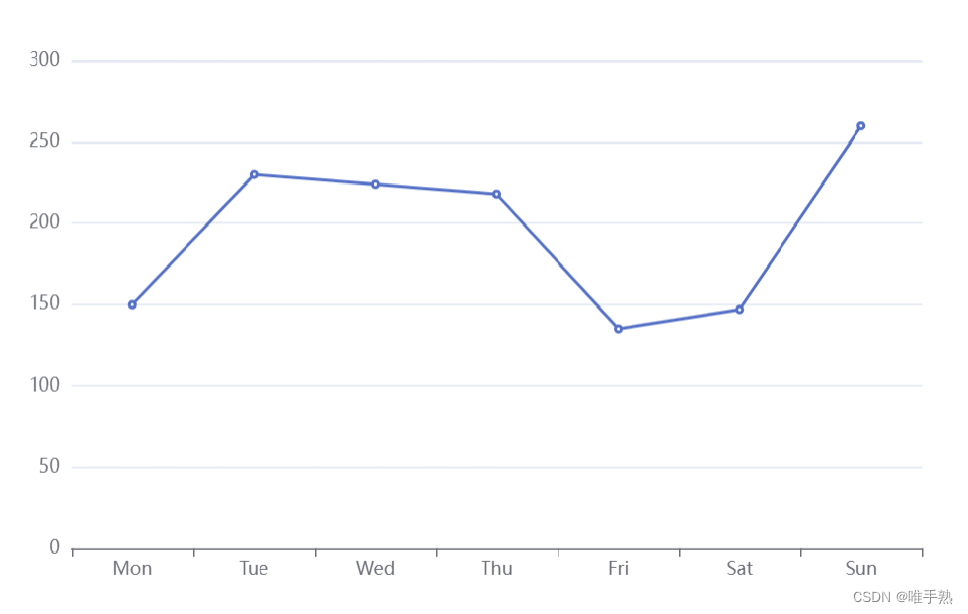
总结:不管是哪种形式的图形,最本质的东西实际上是数据,它其实是对数据的一种可视化展示。
1.2 入门案例
Apache Echarts官方提供的快速入门:快速上手 - 使用手册 - Apache ECharts
效果展示:

实现步骤:
1). 引入echarts.js 文件(当天资料已提供)
2). 为 ECharts 准备一个设置宽高的 DOM
3). 初始化echarts实例
4). 指定图表的配置项和数据
5). 使用指定的配置项和数据显示图表
代码开发:
<!DOCTYPE html>
<html>
?<head>
? ?<meta charset="utf-8" />
? ?<title>ECharts</title>
? ?<!-- 引入刚刚下载的 ECharts 文件 -->
? ?<script src="echarts.js"></script>
?</head>
?<body>
? ?<!-- 为 ECharts 准备一个定义了宽高的 DOM -->
? ?<div id="main" style="width: 600px;height:400px;"></div>
? ?<script type="text/javascript">
? ? ?// 基于准备好的dom,初始化echarts实例
? ? ?var myChart = echarts.init(document.getElementById('main'));
?
? ? ?// 指定图表的配置项和数据
? ? ?var option = {
? ? ? ?title: {
? ? ? ? ?text: 'ECharts 入门示例'
? ? ? },
? ? ? ?tooltip: {},
? ? ? ?legend: {
? ? ? ? ?data: ['销量']
? ? ? },
? ? ? ?xAxis: {
? ? ? ? ?data: ['衬衫', '羊毛衫', '雪纺衫', '裤子', '高跟鞋', '袜子']
? ? ? },
? ? ? ?yAxis: {},
? ? ? ?series: [
? ? ? ? {
? ? ? ? ? ?name: '销量',
? ? ? ? ? ?type: 'bar',
? ? ? ? ? ?data: [5, 20, 36, 10, 10, 20]
? ? ? ? }
? ? ? ]
? ? };
?
? ? ?// 使用刚指定的配置项和数据显示图表。
? ? ?myChart.setOption(option);
? ?</script>
?</body>
</html>总结:使用Echarts,重点在于研究当前图表所需的数据格式。通常是需要后端提供符合格式要求的动态数据,然后响应给前端来展示图表。
2. 营业额统计
2.1 需求分析和设计
2.1.1 产品原型
营业额统计是基于折现图来展现,并且按照天来展示的。实际上,就是某一个时间范围之内的每一天的营业额。同时,不管光标放在哪个点上,那么它就会把具体的数值展示出来。并且还需要注意日期并不是固定写死的,是由上边时间选择器来决定。比如选择是近7天、或者是近30日,或者是本周,就会把相应这个时间段之内的每一天日期通过横坐标展示。
原型图:
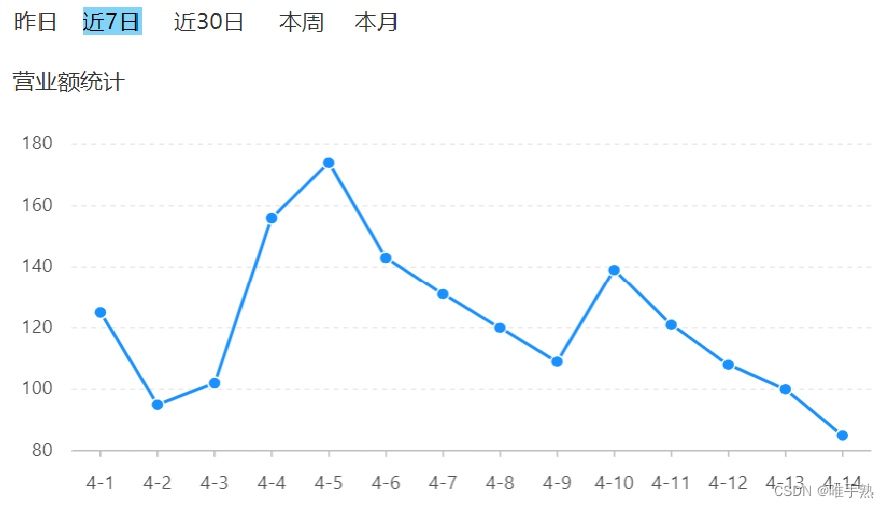
业务规则:
-
营业额指订单状态为已完成的订单金额合计
-
基于可视化报表的折线图展示营业额数据,X轴为日期,Y轴为营业额
-
根据时间选择区间,展示每天的营业额数据
2.1.2 接口设计
通过上述原型图,设计出对应的接口。
查询类的操作GET
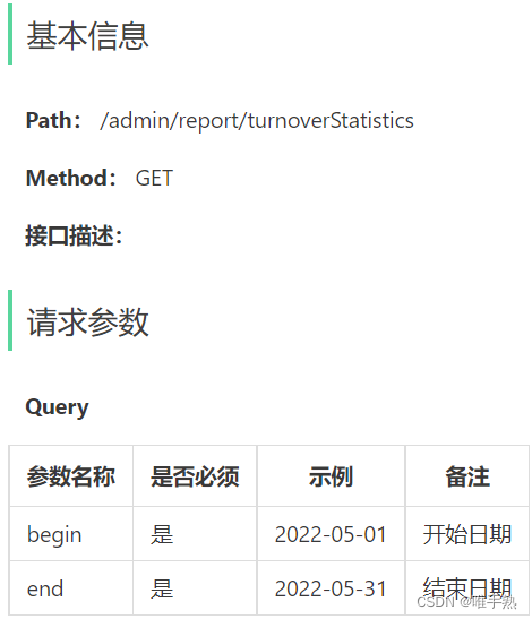
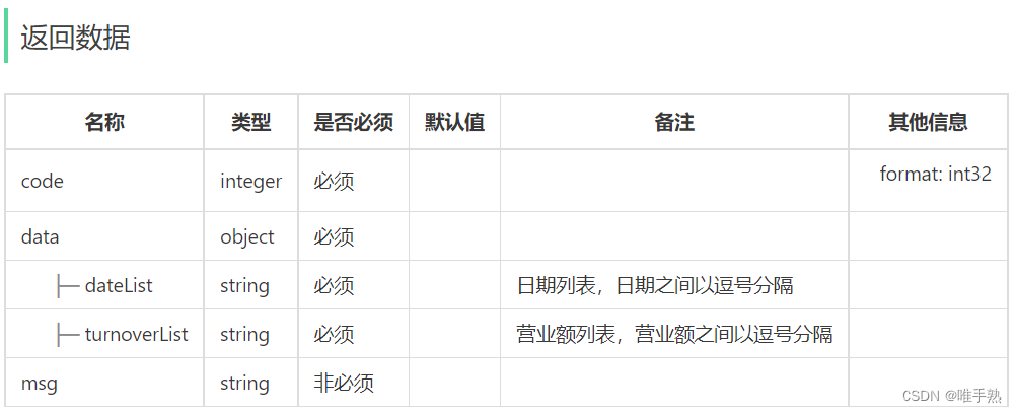
注意:具体返回数据一般由前端来决定,前端展示图表,具体折现图对应数据是什么格式,是有固定的要求的。 所以说,后端需要去适应前端,它需要什么格式的数据,我们就给它返回什么格式的数据。
2.2 代码开发
在pojo模块,TurnoverReportVO.java
实现前端需求的数据返回格式。
?
import lombok.AllArgsConstructor;
import lombok.Builder;
import lombok.Data;
import lombok.NoArgsConstructor;
?
import java.io.Serializable;
?
@Data
@Builder
@NoArgsConstructor
@AllArgsConstructor
public class TurnoverReportVO implements Serializable {
?
? ?//日期,以逗号分隔,例如:2022-10-01,2022-10-02,2022-10-03
? ?private String dateList;
?
? ?//营业额,以逗号分隔,例如:406.0,1520.0,75.0
? ?private String turnoverList;
?
}2.2.2 Controller层
根据接口定义创建ReportController:
?
import io.swagger.annotations.Api;
import io.swagger.annotations.ApiOperation;
import lombok.extern.slf4j.Slf4j;
import org.springframework.beans.factory.annotation.Autowired;
import org.springframework.format.annotation.DateTimeFormat;
import org.springframework.web.bind.annotation.GetMapping;
import org.springframework.web.bind.annotation.RequestMapping;
import org.springframework.web.bind.annotation.RestController;
?
import javax.servlet.http.HttpServletResponse;
import java.time.LocalDate;
?
/**
* 数据统计相关接口
*/
@RestController
@RequestMapping("/admin/report")
@Api(tags = "数据统计相关接口")
@Slf4j
public class ReportController {
?
? ?@Autowired
? ?private ReportService reportService;
?
? ?/**
? ? * 营业额统计
? ? * @param begin
? ? * @param end
? ? * @return
? ? */
? ?@GetMapping("/turnoverStatistics")
? ?@ApiOperation("营业额统计")
? ?//接收日期并封装格式
? ?public Result<TurnoverReportVO> turnoverStatistics(
? ? ? ? ? ?@DateTimeFormat(pattern = "yyyy-MM-dd") ?LocalDate begin,
? ? ? ? ? ?@DateTimeFormat(pattern = "yyyy-MM-dd") LocalDate end){
? ? ? ?log.info("营业额数据统计:{},{}",begin,end);
? ? ? ?return Result.success(reportService.getTurnoverStatistics(begin,end));
? }2.2.3 Service层接口
创建ReportService接口,声明getTurnover方法:
import javax.servlet.http.HttpServletResponse;
import java.time.LocalDate;
?
public interface ReportService {
?
? ?/**
? ? * 统计指定时间区间内的营业额数据
? ? * @param begin
? ? * @param end
? ? * @return
? ? */
? ?TurnoverReportVO getTurnoverStatistics(LocalDate begin, LocalDate end);2.2.4 Service层实现类
-
根据时间获取数据
-
数据判断和封装返回
创建ReportServiceImpl实现类,实现getTurnover方法:
import lombok.extern.slf4j.Slf4j;
import org.apache.commons.lang3.StringUtils;
import org.apache.poi.xssf.usermodel.XSSFRow;
import org.apache.poi.xssf.usermodel.XSSFSheet;
import org.apache.poi.xssf.usermodel.XSSFWorkbook;
import org.springframework.beans.factory.annotation.Autowired;
import org.springframework.stereotype.Service;
?
import javax.servlet.ServletOutputStream;
import javax.servlet.http.HttpServletResponse;
import java.io.IOException;
import java.io.InputStream;
import java.time.LocalDate;
import java.time.LocalDateTime;
import java.time.LocalTime;
import java.util.ArrayList;
import java.util.HashMap;
import java.util.List;
import java.util.Map;
import java.util.stream.Collectors;
?
@Service
@Slf4j
public class ReportServiceImpl implements ReportService {
?
? ?@Autowired
? ?private OrderMapper orderMapper;
? ?@Autowired
? ?private UserMapper userMapper;
?
?
? ?@Autowired
? ?private WorkspaceService workspaceService;
?
? ?/**
? ? * 统计指定时间区间内的营业额数据
? ? *
? ? * @param begin
? ? * @param end
? ? * @return
? ? */
? ?public TurnoverReportVO getTurnoverStatistics(LocalDate begin, LocalDate end) {
?
? ? ? ?//1、当前集合用于存放从begin到end范围内的每天的日期
? ? ? ?List<LocalDate> dateList = new ArrayList<>();
?
? ? ? ?dateList.add(begin);
?
? ? ? ?//遍历添加集合
? ? ? ?while (!begin.equals(end)) {
? ? ? ? ? ?//日期计算,计算指定日期的后一天对应的日期
? ? ? ? ? ?begin = begin.plusDays(1);
? ? ? ? ? ?dateList.add(begin);
? ? ? }
?
? ? ? ?//2、存放每天的营业额
? ? ? ?List<Double> turnoverList = new ArrayList<>();
?
? ? ? ?for (LocalDate date : dateList) {
?
? ? ? ? ? ?//查询date日期对应的营业额数据,营业额是指:状态为“已完成”的订单金额合计.
? ? ? ? ? ?//将date时间细化成秒,用于匹配到秒下单的时间。一天的开始与结束时刻。
? ? ? ? ? ?LocalDateTime beginTime = LocalDateTime.of(date, LocalTime.MIN);
? ? ? ? ? ?LocalDateTime endTime = LocalDateTime.of(date, LocalTime.MAX);
?
? ? ? ? ? ?// 数据查询SQL :select sum(amount) from orders where order_time > beginTime and order_time < endTime and status = 5
? ? ? ? ? ?//数据格式封装map
? ? ? ? ? ?Map map = new HashMap();
? ? ? ? ? ?map.put("begin", beginTime);
? ? ? ? ? ?map.put("end", endTime);
? ? ? ? ? ?map.put("status", Orders.COMPLETED);
?
? ? ? ? ? ?Double turnover = orderMapper.sumByMap(map);
?
? ? ? ? ? ?//如果今天没有订单为null,将null转为0,解决这个小bug!!!
? ? ? ? ? ?turnover = turnover == null ? 0.0 : turnover;
? ? ? ? ? ?//将元素封装成集合
? ? ? ? ? ?turnoverList.add(turnover);
? ? ? }
?
? ? ? ?//3、构建-封装返回结果(list——>String)
? ? ? ?return TurnoverReportVO
? ? ? ? ? ? ? .builder()
? ? ? ? ? ? ? .dateList(StringUtils.join(dateList, ","))
? ? ? ? ? ? ? .turnoverList(StringUtils.join(turnoverList, ","))
? ? ? ? ? ? ? .build();
? }2.2.5 Mapper层
在OrderMapper接口声明sumByMap方法:
/**
? ? * 根据动态条件统计营业额
? ? * @param map
? ? */
? ?Double sumByMap(Map map);在OrderMapper.xml文件中编写动态SQL:
<select id="sumByMap" resultType="java.lang.Double">
? ? ? select sum(amount) from orders
? ? ? ?<where>
? ? ? ? ? ?<if test="status != null">
? ? ? ? ? ? ? and status = #{status}
? ? ? ? ? ?</if>
? ? ? ? ? ?<if test="begin != null">
? ? ? ? ? ? ? and order_time >= #{begin}
? ? ? ? ? ?</if>
? ? ? ? ? ?<if test="end != null">
? ? ? ? ? ? ? and order_time <= #{end}
? ? ? ? ? ?</if>
? ? ? ?</where>
</select>2.3 功能测试
可以通过如下方式进行测试:
-
接口文档测试
-
前后端联调测试
启动服务器,启动nginx,直接采用前后端联调测试。
2.4 代码提交
3. 用户统计
3.1 需求分析和设计
3.1.1 产品原型
所谓用户统计,实际上统计的是用户的数量。通过折线图来展示,上面这根蓝色线代表的是用户总量,下边这根绿色线代表的是新增用户数量,是具体到每一天。所以说用户统计主要统计两个数据,一个是总的用户数量,另外一个是新增用户数量。
原型图:
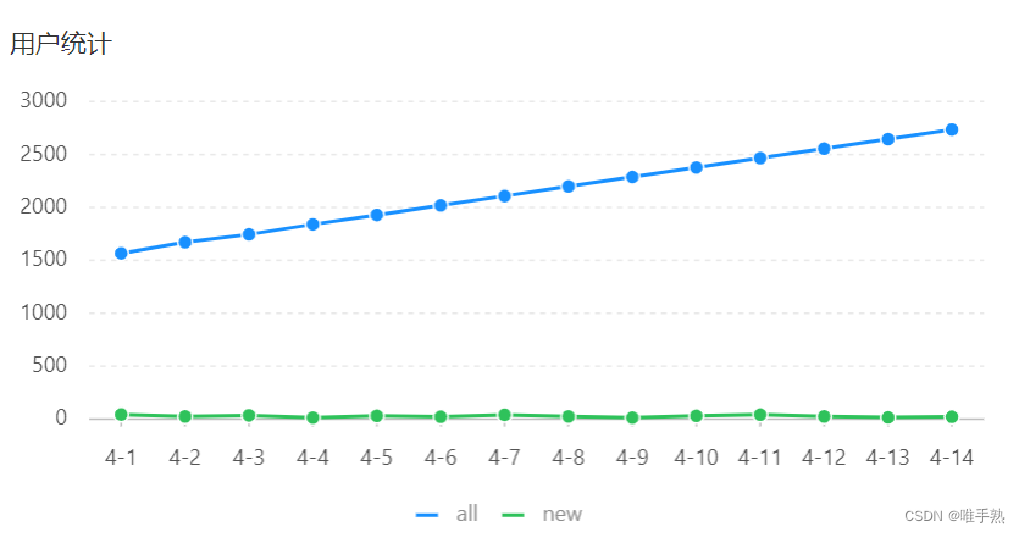
业务规则:
-
基于可视化报表的折线图展示用户数据,X轴为日期,Y轴为用户数
-
根据时间选择区间,展示每天的用户总量和新增用户量数据
3.1.2 接口设计
根据上述原型图设计接口。

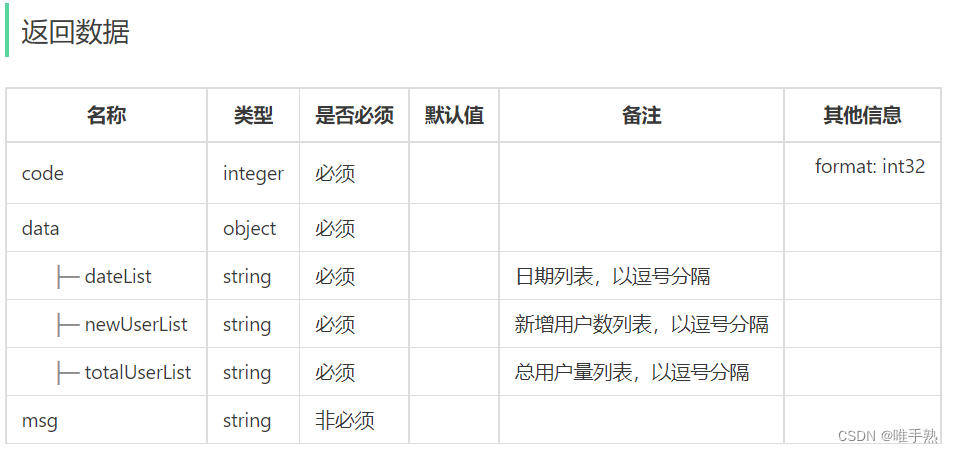
3.2 代码开发
在pojo模块,UserReportVO.java已定义
?
import lombok.AllArgsConstructor;
import lombok.Builder;
import lombok.Data;
import lombok.NoArgsConstructor;
import java.io.Serializable;
?
@Data
@Builder
@NoArgsConstructor
@AllArgsConstructor
public class UserReportVO implements Serializable {
?
? ?//日期,以逗号分隔,例如:2022-10-01,2022-10-02,2022-10-03
? ?private String dateList;
?
? ?//用户总量,以逗号分隔,例如:200,210,220
? ?private String totalUserList;
?
? ?//新增用户,以逗号分隔,例如:20,21,10
? ?private String newUserList;
?
}3.2.2 Controller层
根据接口定义,在ReportController中创建userStatistics方法:
/**
? ? * 用户数据统计
? ? * @param begin
? ? * @param end
? ? * @return
? ? */
? ?@GetMapping("/userStatistics")
? ?@ApiOperation("用户数据统计")
? ?public Result<UserReportVO> userStatistics(
? ? ? ? ? ?@DateTimeFormat(pattern = "yyyy-MM-dd") LocalDate begin,
? ? ? ? ? ?@DateTimeFormat(pattern = "yyyy-MM-dd") LocalDate end){
?
? ? ? ?return Result.success(reportService.getUserStatistics(begin,end)); ? ? ? ? ? ?
}3.2.3 Service层接口
在ReportService接口中声明getUserStatistics方法:
/**
? ? * 根据时间区间统计用户数量
? ? * @param begin
? ? * @param end
? ? * @return
? ? */
? ?UserReportVO getUserStatistics(LocalDate begin, LocalDate end);3.2.4 Service层实现类
在ReportServiceImpl实现类中实现getUserStatistics方法:
@Autowired
? ?private UserMapper userMapper;
?
/**
? ? * 统计指定时间区间内的用户数据
? ? *
? ? * @param begin
? ? * @param end
? ? * @return
? ? */
? ?public UserReportVO getUserStatistics(LocalDate begin, LocalDate end) {
? ? ? ?//存放从begin到end之间的每天对应的日期
? ? ? ?List<LocalDate> dateList = new ArrayList<>();
?
? ? ? ?dateList.add(begin);
?
? ? ? ?while (!begin.equals(end)) {
? ? ? ? ? ?begin = begin.plusDays(1);
? ? ? ? ? ?dateList.add(begin);
? ? ? }
?
? ? ? ?//存放每天的新增用户数量(当天注册数) select count(id) from user where create_time < ? and create_time > ?
? ? ? ?List<Integer> newUserList = new ArrayList<>();
? ? ? ?//存放每天的总用户数量 select count(id) from user where create_time < ?
? ? ? ?List<Integer> totalUserList = new ArrayList<>();
?
? ? ? ?//时间细化
? ? ? ?for (LocalDate date : dateList) {
? ? ? ? ? ?LocalDateTime beginTime = LocalDateTime.of(date, LocalTime.MIN);
? ? ? ? ? ?LocalDateTime endTime = LocalDateTime.of(date, LocalTime.MAX);
?
? ? ? ? ? ?Map map = new HashMap();
? ? ? ? ? ?map.put("end", endTime);
? ? ? ? ? ?//总用户数量
? ? ? ? ? ?Integer totalUser = userMapper.countByMap(map);
?
? ? ? ? ? ?map.put("begin", beginTime);
? ? ? ? ? ?//新增用户数量
? ? ? ? ? ?Integer newUser = userMapper.countByMap(map);
?
? ? ? ? ? ?totalUserList.add(totalUser);
? ? ? ? ? ?newUserList.add(newUser);
? ? ? }
?
? ? ? ?//封装结果数据
? ? ? ?return UserReportVO
? ? ? ? ? ? ? .builder()
? ? ? ? ? ? ? .dateList(StringUtils.join(dateList, ","))
? ? ? ? ? ? ? .totalUserList(StringUtils.join(totalUserList, ","))
? ? ? ? ? ? ? .newUserList(StringUtils.join(newUserList, ","))
? ? ? ? ? ? ? .build();
? }3.2.5 Mapper层
在UserMapper接口中声明countByMap方法:
/**
* 根据动态条件统计用户数量
* @param map
* @return
*/
Integer countByMap(Map map);在UserMapper.xml文件中编写动态SQL:
/**
? ? * 根据动态条件统计用户数量
? ? * @param map
? ? * @return
? ? */
? ?Integer countByMap(Map map);
在UserMapper.xml文件中编写动态SQL:
<select id="countByMap" resultType="java.lang.Integer">
? ? ? ?select count(id) from user
? ? ? ?<where>
? ? ? ? ? ?<if test="begin != null">
? ? ? ? ? ? ? ?and create_time >= #{begin}
? ? ? ? ? ?</if>
? ? ? ? ? ?<if test="end != null">
? ? ? ? ? ? ? ?and create_time <= #{end}
? ? ? ? ? ?</if>
? ? ? ?</where>
</select>订单统计、销量排名Top10接口设计
订单统计接口设计
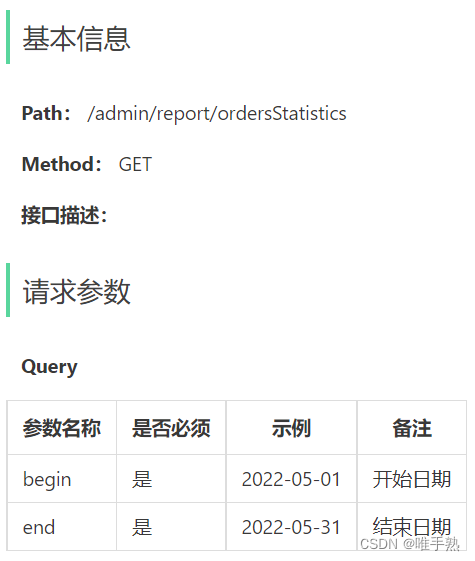
销量排名Top10设计接口。

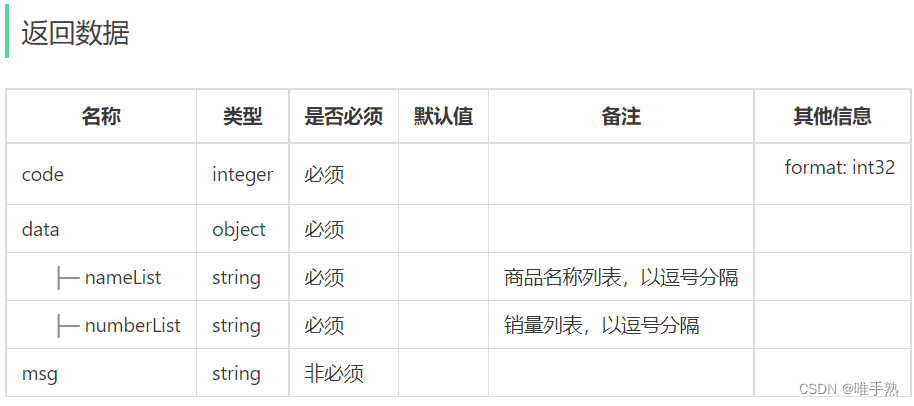
本文来自互联网用户投稿,该文观点仅代表作者本人,不代表本站立场。本站仅提供信息存储空间服务,不拥有所有权,不承担相关法律责任。 如若内容造成侵权/违法违规/事实不符,请联系我的编程经验分享网邮箱:chenni525@qq.com进行投诉反馈,一经查实,立即删除!
- Python教程
- 深入理解 MySQL 中的 HAVING 关键字和聚合函数
- Qt之QChar编码(1)
- MyBatis入门基础篇
- 用Python脚本实现FFmpeg批量转换
- 漂亮不是梦!Java Swing美化攻略
- 抖音IP属地显示教程:一分钟轻松解决换地址问题
- opencv009 滤波器01(卷积)
- 一文带你了解机器学习算法
- js按顺序循环接口返回数据,组合成新数据
- 属龙人的性格命运怎么样呢?
- 隔夜挂单的成交规则科普
- 西门子S7-1200直接连接MySQL数据库
- Java ByteBuffer使用全解析
- JavaWeb—html, css, javascript, dom,xml, tomcat&servlet
